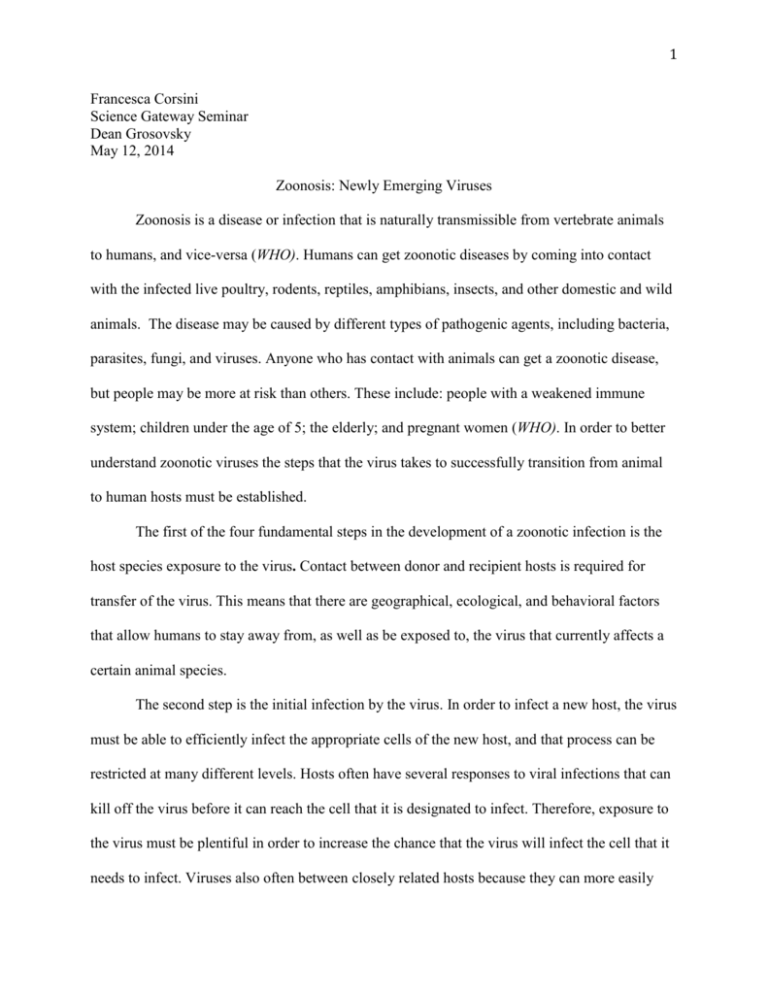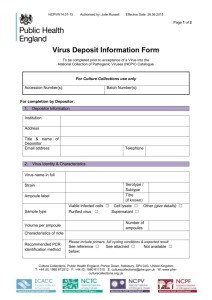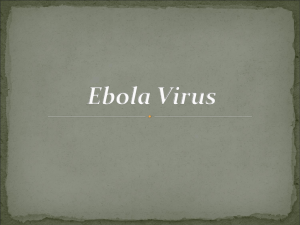Research Paper Francesca Corsini
advertisement

1 Francesca Corsini Science Gateway Seminar Dean Grosovsky May 12, 2014 Zoonosis: Newly Emerging Viruses Zoonosis is a disease or infection that is naturally transmissible from vertebrate animals to humans, and vice-versa (WHO). Humans can get zoonotic diseases by coming into contact with the infected live poultry, rodents, reptiles, amphibians, insects, and other domestic and wild animals. The disease may be caused by different types of pathogenic agents, including bacteria, parasites, fungi, and viruses. Anyone who has contact with animals can get a zoonotic disease, but people may be more at risk than others. These include: people with a weakened immune system; children under the age of 5; the elderly; and pregnant women (WHO). In order to better understand zoonotic viruses the steps that the virus takes to successfully transition from animal to human hosts must be established. The first of the four fundamental steps in the development of a zoonotic infection is the host species exposure to the virus. Contact between donor and recipient hosts is required for transfer of the virus. This means that there are geographical, ecological, and behavioral factors that allow humans to stay away from, as well as be exposed to, the virus that currently affects a certain animal species. The second step is the initial infection by the virus. In order to infect a new host, the virus must be able to efficiently infect the appropriate cells of the new host, and that process can be restricted at many different levels. Hosts often have several responses to viral infections that can kill off the virus before it can reach the cell that it is designated to infect. Therefore, exposure to the virus must be plentiful in order to increase the chance that the virus will infect the cell that it needs to infect. Viruses also often between closely related hosts because they can more easily 2 infect a cell of a new host that is similar to that a previous host; mutations to the virus's genome is how this ability to cross species is acquired. The third step to the development of a zoonotic virus is the spread of the virus to other members of the host population. Population density plays a large role in the exposure to a virus, as well as the occurrence of epidemics. This is because the virus is able to find many new hosts to infect in a dense population and can use those hosts for reproduction even if the original host has died from infection. The final step in the development of a zoonotic virus is the adaptations that the virus acquires in order to infect the host species more effectively. While a certain virus may effectively infect a host and spread throughout a population, its survival is not ensured, especially when considering the current advances in medicine that can prevent infection and kill an existing virus in a host. This is why a virus that is able to "change" frequently (for example, one with a high mutation rate) has an advantage over other viruses. These viruses cannot easily be identified and used for vaccinations because their genome is constantly changing and one vaccination may not be effective for a newer version of the virus. Once these zoonotic viruses are able to infect humans the effects that each particular virus has can be profound and vary greatly from virus to virus. One example of a zoonotic disease that has recently developed is the Avian Influenza (H5N1 Bird Flu). H5N1 is a highly pathogenic avian bird flu virus, which was first detected in China in 1996 from a goose. Outbreaks in parts of Asia and the Middle East were caused over interactions between humans and domestic poultry. Currently, there is no proof that the virus can spread from human to human but possible adaptations pose threats. There have been about 650 human cases reported from 15 different countries since 2003 (Flu.gov). Mortality rate is about 60% of those infected with the 3 virus (Flu.Gov). Common symptoms of those infected with H5N1 include: “fever and cough; acute respiratory distress; shortness of breath/difficulty breathing; abdominal pain; diarrhea; pneumonia; respiratory failure; shock; altered mental state; seizures; failure of multiple organs (e.g. kidney failure); and death” (Flu.Gov). The only two antiviral medications, which were previously licensed by the FDA to treat those infected, have shown resistance to H5N1. There are three different barriers that a virus must overcome in order to spread from one species to another. The first is cross-species host-host interaction. The species from which the virus originated and the species that received the virus would have to interact first. The second obstacle is virus-host interaction. This depends upon the virus’ ability to infect the next host species. The third barrier is the intra-species host-host interactions. This consists of transferring the virus between infected and non-infected hosts within the species. Infection of Influenza virus depends on the species of the bird and how pathogenic the virus is. For example, H5N1 has high pathogenicity. Highly pathogenic viruses are “characterized by an HA protein with a cleavage site containing multiple basic amino acids, which makes the protein cleavable by proteases ubiquitously present throughout the body rather than only those present at mucosal surfaces” (Parrish, et. all). A third newly emerged zoonotic virus is the H1N1 Virus, commonly known as Swine Flu. This is a respiratory illness and it was found in pigs (CDC). People with daily exposure to pigs are at high risk of swine flu infection, however transmission from pigs to humans is not common. The flu pandemic was first within the United States in 2009. The virus appeared to be a new strain of H1N1, which resulted when a previous triple re-assortment of bird, swine and human flu viruses further combined with a Eurasian pig flu virus (swine flu). 4 The initial outbreak of swine flu was in Mexico, South America. The virus that normally circulates in just pigs, altered so that humans could be affected with the same virus. This virus had two genes from flu viruses that normally circulate in pigs, in Europe and Asia, three genes that normally circulate in North American pigs, and genes from flu viruses from birds and people as well (Centers for Disease Control and Prevention). The method of transmission from pigs to humans (although very rare) is through air-borne droplets from coughing or sneezing of an infected animal. While there is no treatment for H1N1, there are many measures of preventative care, such as getting a flu vaccine. Also, to prevent pig-human transmission of swine flu, farmers are encouraged to wear facemasks when dealing with the infected animals and to also wear gloves so the disease can’t be transmitted through hand-eye, hand-nose, or hand-mouth transmission. Antiviral drugs can also be provided to make the illness tolerable for the patient. The majority of people with the H1N1 virus make a full recovery without acquiring medical attention or antiviral drugs. A final example of a zoonotic disease, which is extremely lethal, is Ebola. The Ebola virus is transmitted from animals to humans via blood contact with an infected animal host and lesions in the hands of a human. The virus then affects the blood of its new host. This then transmits from human to human through direct contact with blood or bodily fluids from another infected person. Also, the virus can be spread via contaminated medical equipment such as shots and needles. There are currently four strains of Ebola known to be able to infect humans and most cases have developed in remote areas of Africa (WebMD). Ebola is a threat to patients and doctors dealing with the disease because it has killed 90% of those infected (CNN.com). Besides trying to keep the patient hydrated and well, there are no known treatments for those infected, 5 which may explain the high rate of death. An individual coming in contact with the bodily fluid of an infected person spreads the disease (USAToday). However the disease may originate from an individual coming into contact with the excretions or blood from animals infected with the disease (WebMD). Symptoms of infection develop relatively quickly and begin to appear “2 to 21 days after infection,” (CNN.com). The early signs include “a rash, red eyes, hiccups, chest pains and difficulty breathing and swallowing” (CNN.com). As infection progresses symptoms lead to vomiting, diarrhea, impaired kidney and liver function and sometimes internal and external bleeding” (CNN.com). The virus feeds off a large population, so the larger the population the worse the effect of the virus. In addition, viruses have emerged to resist more human made prevention methods such as vaccines and antibodies. In the past, viruses would infect a small population and become extinct after the population had died off as it fed off the population for fuel. Now with larger populations throughout the world the spread of the Ebola virus is extremely dangerous and needs to be tackled in order to prevent the deaths of human lives. There are no vaccines or antiviral medications currently given to those infected with the virus. The only defense against infection consists of: remaining out of areas affected by the virus; maintaining proper sanitation; as well as remaining hydrated; and addressing any wounds or rashes that appear if infected with the disease. While we have advanced in understanding the affects of the virus, there are certain aspects that we must continue to explore. These aspects include the study of when and where the virus forms. In addition, we must work to understand what it is that causes the spread of the virus, and how we can limit the virus' natural reservoir, which would in turn, limit the spread of the virus. Often, in order to be affected by a zoonotic disease, there are four key steps: exposure 6 to the virus; infection by the virus; transmission of the virus to members of the population; and the adaptations the virus makes to infect others more effectively. The development of a zoonotic disease occurs through the exchange between humans and animals, and as a first defense against the development of these diseases the exchange of bodily fluids between humans and animals must be addressed. Not only to be sure that the exchanges are humane, but also done cleanly in order to deter any more diseases from developing. 7 Bibliography: CNN.com. "What Is Ebola and Why Does It Kill?" CNN. Cable News Network, 01 Jan. 1970. Web. 13 May 2014. Dur, Jessica. "All You Need to Know about Ebola." USA Today. Gannett, 07 Apr. 2014. Web. 13 May 2014. "Ebola Virus: Symptoms, Treatment, and Prevention." WebMD. WebMD, n.d. Web. 12 May 2014. "H5N1 Avian Flu (H5N1 Bird Flu)." Flu.Gov. H5N1 (Avian Flu). N.p., n.d. Web. 16 May 2014. "Nairaland Forum." No Outbreak Of Ebola Virus In Nigeria- FG. N.p., n.d. Web. 13 May 2014. Nyabbisan, Cameroon. CNN. Cable News Network, n.d. Web. 13 May 2014. Parrish, Colin, Edward Holmes, David Morens, Eun-Chung Park, Donald Burke, Charles Calisher, Catherine Laughlin, Linda Saif, and Peter Daszak. "Cross-Species Virus Transmission and the Emergence of New Epidemic Diseases." Microbiology and Molecular Biology Reviews (n.d.): n. pag. American Society for Microbiology. Web. 13 May 2014. "Use of Antivirals." Centers for Disease Control and Prevention. CDC, 13 Mar. 2014. Web. 16 May 2014. "The 2009 H1N1 Pandemic: Summary Highlights, April 2009-April 2010." Centers for Disease Control and Prevention. Centers for Disease Control and Prevention, n.d. Web. 16 May 2014. 8 "Zoonoses and the Human-Animal-Ecosystems Interface." WHO. N.p., n.d. Web. 13 May 2014.







